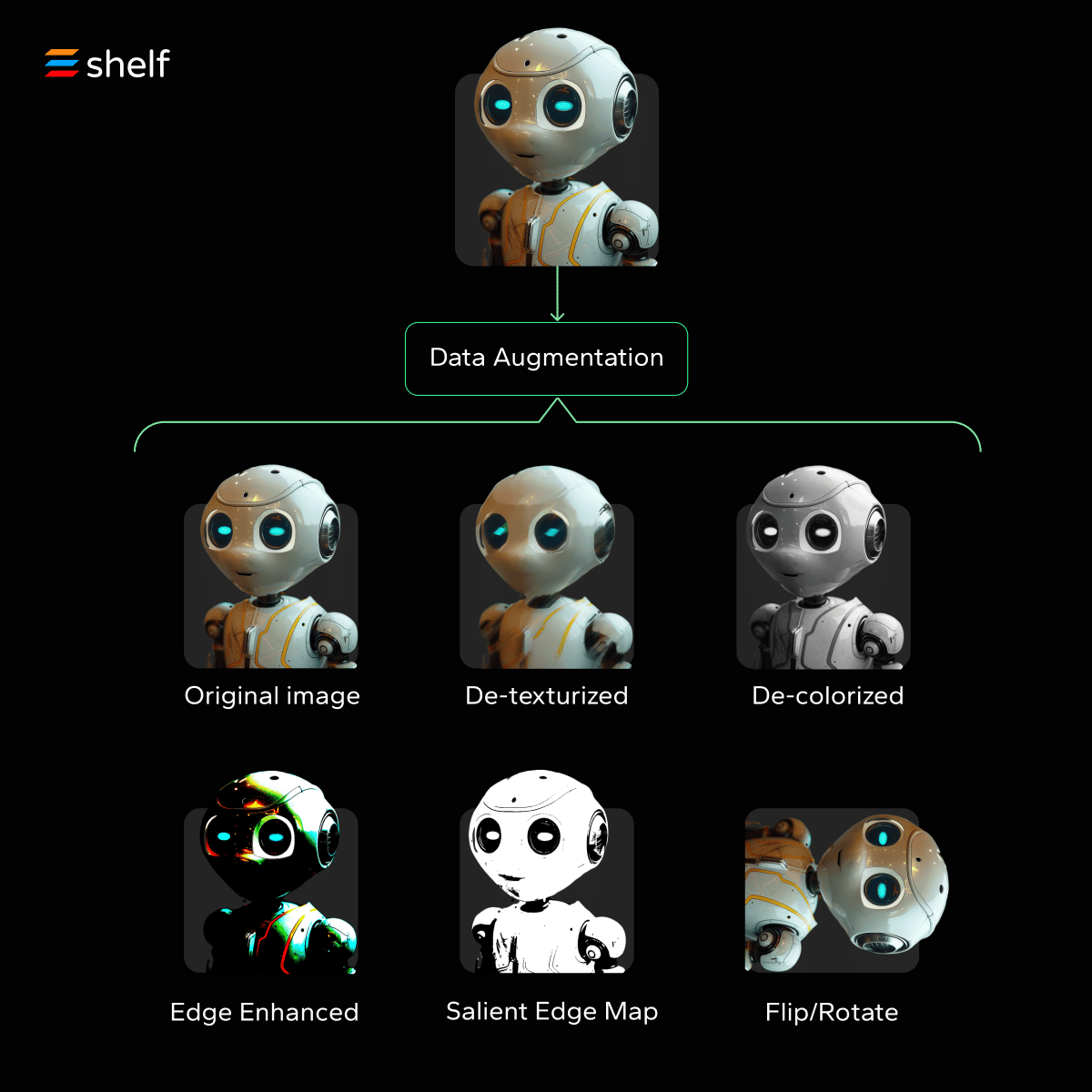Data augmentation is a pivotal technique in the realm of Natural Language Processing (NLP). It’s used to expand and diversify training datasets, thereby enhancing the performance and robustness of AI models.
This technique is crucial for AI practitioners, data scientists, and technologists who aim to develop more accurate, resilient, and nuanced NLP systems.
In this article, we delve into data augmentation in NPL, exploring its benefits, the challenges it presents, and its vast array of real-world applications. You’ll gain a comprehensive understanding of how data augmentation is shaping the future of NLP and why it’s an essential piece of the AI toolkit.
What is Data Augmentation?
Data augmentation in Natural Language Processing is a strategy to artificially increase the volume and diversity of text data without collecting new data through creating modified versions of existing text data that retain its original meaning. This is crucial in NLP because, like in other areas of machine learning, the performance of models often hinges on the quantity and variety of available training data.
The central premise of data augmentation in NLP is to create new, synthetic text data that retains the semantic meaning of the original data. This is done in a way that the augmented data appears to the model as legit, even though they might not have been explicitly gathered or observed in the real world.
Why is this important? In many NLP tasks, from sentiment analysis to language translation, having more data generally leads to better model performance. More data helps in capturing the nuances of language, various ways of expressing the same idea, and different contexts in which words or phrases can be used.
However, unlike in image processing, where you can rotate, zoom, or crop images to create new data, text data requires more nuanced approaches to ensure that the new data maintains grammatical correctness and meaning. The goal is to teach NLP models about the flexibility and variability of language, helping them to make better predictions or understandings when faced with new, unseen text data.
The Benefits of Data Augmentation for NLP Systems
Data augmentation offers a multitude of benefits for NPL systems, enhancing their performance, reliability, and applicability across various domains. Here are some of the key advantages:
Enhanced Model Performance
Data augmentation expands the training dataset, providing NLP models with more examples to learn from, which typically results in improved accuracy, better generalization, and enhanced performance on unseen data.
Increased Robustness
By introducing a variety of linguistic variations into the training data, data augmentation helps models become more robust. This enables them to handle diverse and unexpected inputs, reducing their susceptibility to errors when faced with real-world data variability.
In scenarios where certain classes or examples are underrepresented, data augmentation can help balance the dataset, improving the model’s ability to recognize and accurately classify these less frequent instances.
Reduced Overfitting
Augmentation techniques introduce additional diversity and complexity into the training data, helping models avoid overfitting (where a model learns the training data too well but performs poorly on new data) by encouraging them to learn more generalized patterns.
Improved Generalization
With a richer and more diverse training dataset, NLP systems can better generalize across different linguistic contexts and styles. This makes them more versatile and effective in various applications and environments.
Support for Low-Resource Languages
Data augmentation is particularly beneficial for languages with limited available data, helping to create more robust NLP models for such languages by artificially enlarging the dataset.
Cost Efficiency
Gathering and annotating large datasets can be costly and time-consuming. Data augmentation offers a cost-effective way to enhance the size and diversity of datasets without the need for extensive new data collection and labeling.
How Data Augmentation Works in NLP
Data augmentation in NLP involves artificially increasing the volume and diversity of text data, which helps improve the training and performance of NLP models. The process works by creating variations of the existing data while maintaining the original text’s meaning, thereby providing models with a broader learning base.
In practice, this involves applying a series of transformations to text data that alter its form but not its content or meaning. Techniques like synonym replacement, paraphrasing, and sentence shuffling are common.
These augmentations help NLP models encounter a wider range of language expressions and structures during training, making them more robust and versatile. They learn not just from the specific examples they’re trained on but also from the varied ways a particular idea or sentiment can be expressed. This is particularly beneficial in tasks where the context and nuanced understanding of language are crucial, like sentiment analysis or machine translation.
Moreover, data augmentation addresses the challenge of limited or imbalanced datasets by generating additional training examples. This is especially useful for underrepresented classes or rare linguistic components.
Data Augmentation Methods
In the quest to enhance the performance and robustness of NLP models, data augmentation methods stand out as ingenious solutions that introduce diversity and richness into training datasets. These techniques, ranging from simple synonym replacements to sophisticated back-translation processes, are pivotal in teaching models to navigate the complexities and nuances of human language effectively.
The Most Common Data Augmentation Methods
First, let’s look at some of the most common NPL data augmentation methods.
Synonym Replacement
This method involves identifying key words in a sentence and replacing them with their synonyms. The goal is to retain the sentence’s original meaning while introducing linguistic variations. It helps models learn that different words can convey similar meanings.
Random Insertion
In random insertion, random words are added into sentences at random positions. These words are usually contextually relevant to maintain the sentence’s overall meaning. This technique helps to create more robust models by teaching them to deal with unexpected words in sentences and focus on the broader context.
Random Swap
This technique swaps words within a sentence, changing the order but not the words themselves. By altering the structure without losing meaning, it challenges models to understand language beyond fixed word orders, enhancing their grasp of syntax and context.
Random Deletion
Random deletion involves randomly removing words from a sentence without affecting the core message. This method tests the model’s ability to comprehend text even when it’s incomplete or missing information.
Back-translation
Text is translated from one language to another and then back to the original language. The process often introduces subtle variations in phrasing and structure, providing a form of paraphrasing. It’s particularly useful for increasing the diversity of sentence structures in training data.
Text Paraphrasing
This method rewrites sentences with different words and grammar while keeping the original meaning. Paraphrasing can be automated using AI models that understand context and synonyms, which helps to produce varied training examples that teach the nuances of language.
Word Embedding Replacement
Words in a sentence are replaced with similar words based on their embeddings (vector representations capturing semantic meaning). This encourages models to not rely solely on specific words but to understand the broader semantic context of sentences.
More Data Augmentation Methods
Now let’s look at some less popular NPL data augmentation methods.
Sentence Shuffling rearranges the order of sentences within a paragraph to create new contextual sequences without altering individual sentence meanings.
Lexical Substitution swaps words with their lexical equivalents, such as replacing a word with its synonym or antonym.
Noise Injection introduces random noise into text data, like spelling errors or grammatical mistakes, to enhance model robustness.
Morphological Variations alters word forms by changing their tense, number, or other grammatical attributes to generate diverse linguistic structures.
Keyboard Typo Generation simulates typing errors that occur due to the proximity of keys on a keyboard, creating realistic misspellings.
Homophone Substitution replaces words with their homophones, introducing variations that sound the same but are spelled differently.
Contextual Word Embeddings Insertion inserts words based on their contextual compatibility, guided by models like BERT that understand context.
N-gram Shuffling rearranges contiguous sequences of n items (words or characters) within the text to create new patterns.
Rule-based Augmentation applies predefined linguistic rules to alter text, such as changing gender or number.
Phonetic Perturbation modifies words based on their phonetic properties, creating variations that sound similar but are spelled differently.
Controlled Noising introduces specific types of noise into the text deliberately, rather than randomly, to test or enhance certain model capabilities.
Data Mixing combines text from different sources or data points to create new composite samples.
GAN-based Augmentation utilizes Generative Adversarial Networks to create new text data that is indistinguishable from genuine samples.
Cross-lingual Augmentation translates text into different languages and back again or uses multilingual data to enrich the training set.
Entity Substitution replaces named entities (like names, locations) with other entities to generate text variations while keeping the narrative consistent.
Tense Variation changes the tense of verbs throughout a text, offering a temporal perspective shift.
Voice Conversion transforms sentences from active to passive voice or vice versa, altering the sentence structure while preserving the original information.
Numeral Variation alters numbers in the text, either by switching formats (words to digits, vice versa) or changing numerical values slightly.
Abbreviation Expansion expands abbreviations or acronyms to their full forms or contracts full forms to their abbreviations.
Text Inversion inverts the sentence structure or word order, challenging conventional syntax while maintaining the core message.
HTML Tag Injection adds or alters HTML tags in text data to simulate or test the influence of markup on text processing.
Semantic Text Exchange replaces text segments with others that have a similar meaning but different wording, maintaining the thematic essence.
Real-World Applications of NLP Data Augmentation
Data augmentation in NLP plays a pivotal role in many real-world applications. Here’s how this technique is making a significant impact across different sectors:
- Virtual Assistants: Data augmentation enables them to understand a wider array of user queries with greater accuracy.
- Machine Translation: Data augmentation enables translation models to handle a broader range of linguistic structures and idioms, reducing errors and improving the overall quality of translated text.
- Sentiment Analysis: Data augmentation helps models classify and understand feedback across different communication styles and platforms.
- Content Moderation: Augmented data trains models to detect and act on a wider spectrum of inappropriate or harmful content, even when presented in nuanced ways.
- Healthcare Communication: Data augmentation enhances the ability of NLP systems to process medical terminology and patient queries with higher precision.
- Educational Tools: Augmented data aids in developing tools that can understand and respond to student inputs in various forms, adapting to individual learning styles.
- Customer Service Automation: Augmented data helps chatbots and support systems understand and respond to a wide range of customer inquiries.
In each of these applications, data augmentation not only enhances the capabilities of NLP systems but also broadens their applicability and effectiveness.
Best Practices for Using Data Augmentation in NPL
In order to implement data augmentation effectively, it’s important to follow some best practices. This advice will help you achieve enhanced performance and reliability of your NLP models.
1. Understand Your Data and Objectives
Before applying augmentation techniques, have a clear understanding of your dataset and the specific goals of your NLP project. This understanding will guide the selection of the most appropriate augmentation methods that align with your objectives.
2. Choose Relevant Augmentation Techniques
Not all augmentation methods are suitable for every NLP task. Select methods that are relevant to the nature of your text data and the specific challenges you aim to address, such as enhancing model robustness or addressing class imbalance.
3. Maintain Data Quality
While augmenting data, it’s crucial to ensure that the new data maintains the original’s quality and relevance. The augmented data should not introduce noise or irrelevant variations that could degrade model performance.
4. Balance Variety and Realism
Introduce a balanced level of variation through augmentation. While diversity is desired, the augmented data should still be realistic and representative of the scenarios the model will encounter in real-world applications.
5. Monitor the Impact
Regularly evaluate the impact of data augmentation on your model’s performance. Continuous monitoring helps you understand the effectiveness of different augmentation methods and in making necessary adjustments.
6. Avoid Bias Introduction
Be cautious not to introduce or amplify biases in your dataset through augmentation. Ensure that the augmented data is diverse and unbiased, reflecting a wide range of scenarios and linguistic styles.
7. Leverage Domain Knowledge
Utilize domain-specific knowledge to guide the data augmentation process. Ensure that the techniques applied are contextually appropriate and contribute to the model’s understanding of the domain-specific language.
8. Iterate and Optimize
Data augmentation in NLP is an iterative process. Experiment with different techniques, assess their impact, and refine your approach based on the outcomes to find the optimal augmentation strategy for your specific use case.
Challenges and Considerations of Data Augmentation
While data augmentation offers significant benefits for NLP, it also comes with its set of challenges and considerations that practitioners need to navigate:
One of the primary challenges is ensuring that the augmented data retains the original text’s meaning. Inaccurate augmentation can lead to data that misrepresents the initial intent. This runs the risk of degrading the model’s performance.
Second, augmentation methods must maintain the context of the original data. Especially in NLP, it’s important that augmentations do not distort the linguistic and situational context of the text. Augmentation must also be careful of introducing bias into the data.
Third, care must be taken to balance diversity with relevance. Over-augmentation or irrelevant modifications can introduce noise, leading to models that are less effective on real-world data.
Finally, we must be careful of overfitting. If a model is overly trained on augmented data, there’s a risk it might overfit to the characteristics of the augmented data rather than learning the broader, generalizable patterns.
Addressing these challenges requires a thoughtful and strategic approach to data augmentation, including rigorous testing, continuous evaluation, and an awareness of the potential pitfalls.
The Future of Data Augmentation in NLP
The future of data augmentation in NLP is poised to revolutionize AI systems, making them more adept at interpreting and responding to human language.
We anticipate seeing advancements in AI-driven augmentation, with more sophisticated models like GPT-4 creating highly realistic and contextually relevant augmented data. The integration with multimodal data will enable NLP models to process and interpret a mix of text, speech, images, and video, broadening their applicability.
There will be a shift towards personalization and contextual augmentation, tailoring the process to specific user needs and enhancing the precision of NLP applications across various sectors.
Ethical and responsible augmentation will become paramount to avoid introducing or amplifying biases, especially in sensitive areas like healthcare and finance. The focus will also extend to enhancing cross-lingual understanding and improving performance for low-resource languages, aiding in global inclusivity.
Moreover, data augmentation will become more automated and adaptive, with systems efficiently determining optimal augmentation strategies, contributing to the robustness and generalization of NLP models. This evolution signifies a move towards more nuanced, adaptable, and intelligent AI solutions, fundamentally changing our interaction with technology.
Embrace Data Augmentation Mindfully
Data augmentation stands as a cornerstone technique in NLP, offering a pathway to enhance AI models’ understanding, versatility, and accuracy. As we’ve explored, it offers significant benefits and applications, yet it comes with its own set of challenges. Embracing data augmentation with a mindful approach can propel the capabilities of your NLP systems, paving the way for more advanced and effective AI solutions in various domains.




